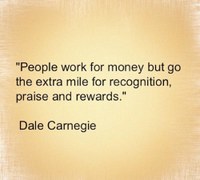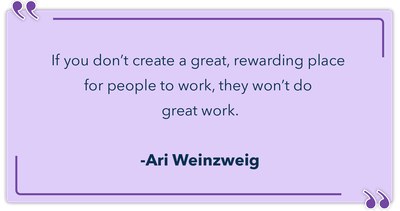Recognition- Doing It the Right Way
 David Novak, the former CEO of YUM! Brands narrated the story of when he asked a group of salesmen what marketing tactics were working on them. Everyone pointed to one person, Bob. There was a unanimous theme of appreciation for the different ways in which Bob had helped them and for the value he brought to the sales team. Bob was overcome with emotion and had tears running down his face. Bob said that he had worked in that company for 47 years and was set to retire in two weeks but had no idea that his co-workers felt that way about him.
David Novak, the former CEO of YUM! Brands narrated the story of when he asked a group of salesmen what marketing tactics were working on them. Everyone pointed to one person, Bob. There was a unanimous theme of appreciation for the different ways in which Bob had helped them and for the value he brought to the sales team. Bob was overcome with emotion and had tears running down his face. Bob said that he had worked in that company for 47 years and was set to retire in two weeks but had no idea that his co-workers felt that way about him.
It is an unfortunate reality that there are many “Bobs” in the world. People tend to lose motivation and interest in their jobs when they feel unnoticed and unappreciated, causing them to eventually leave. I recall an incident in 2016 when I just started working at the University of Louisville Dental School, straight out of residency. The Dean had organized a Faculty and Staff Retreat at ULSD. He asked the group if we would like to recognize anybody, and I spontaneously raised my hand and said a co-worker’s name. This employee was a member of the support staff whose office was in the basement. They would always greet me pleasantly and always made me feel very welcome. It was not only because I was new, I had seen him do the same with everyone that crossed his path. I had never heard him complain about anything!
This was a small moment, but little did I know the importance of what I was doing and the power of recognition. I was introduced to the concept of “Employee Recognition” through the Leadership in Innovation and Academic Medicine (LIAM) program and where I completed an online course called “Purposeful Recognition” offered by David Novak Leadership. From that module, I learned how vital employee engagement is to any organization’s success, driving innovation, and high performance. Engaged employees are rare. According to Gallup, only 33% of the employees are engaged in the work that they are doing. Disengaged employees are detrimental to an organization, especially when they are in leadership or supervisor roles. Actively disengaged employees can negatively impact productivity, customer/patient service, safety, and quality. On the other hand, highly engaged employees who choose to be a part of solutions rather than let problems be a cause for unproductivity are inherently driven and work with passion. However, not every employee has this innate drive, but every employee needs engagement in order for a company to grow.
 There are many ways to improve employee engagement, and purposeful recognition is at the top of that list. The key is purposeful recognition. Recognition is an art that needs to be done the right way. Recognition must be:
There are many ways to improve employee engagement, and purposeful recognition is at the top of that list. The key is purposeful recognition. Recognition is an art that needs to be done the right way. Recognition must be:
- meaningful,
- spontaneous
- specific, and
- done often
If recognition is done often, it must also be heartfelt and genuine; otherwise, it becomes arduous.
A leader needs to be introspective and identify what they are most comfortable doing. For example, whether one wants to recognize face to face in a group meeting or let the employee know through an appreciative note. Indra Nooyi, the former CEO of PepsiCo, would write letters of appreciation to her executives’ parents, thanking them for the gift of their children to PepsiCo. These notes made a tremendous positive impact on her employees and created a profound connection to their company. Recognition must be meaningful and tailored to the individual receiving it, in order to improve engagement. Recognition must happen spontaneously and cannot wait until a big event or an annual celebration to acknowledge the dedication, positive attitude, and discipline. It is essential to create momentum and keep the momentum going by celebrating small wins along the way.

When the act of recognizing is specific to a particular behavior, it improves motivation and drives organizational success. When a leader lets an employee know why they are being rewarded, it creates a culture where recognition is earned and that the leader notices employee performance and cares to highlight it. Recognition can be so powerful when leaders are intentional about it and build it into their daily routine. It is equally crucial for a leader to recognize counterproductive behavior. According to a Gallup report, disengaged employees are unhappy at work, but they are focused on acting out their unhappiness and actively working to undermine progress. A leader needs to hold these employees accountable, provide specific feedback, and give them a chance (or two) to take corrective action.

There are several perceived barriers to recognition. For instance, recognizing one employee may inadvertently de-motivate and create an unhealthy environment among other employees if it is not done for everyone equally. Another barrier could be that it is expensive. If recognition is done mindfully and in a disciplined manner, these barriers can be overcome. Additionally, recognizing essential behaviors that are tied to the goals of an organization and its success and not just the results is another effective way to overcome some of the aforementioned barriers. An interesting statistic shows that about 60% of people are more motivated by recognition than money. Recognition is a beautiful approach that helps bring greatness out of people who don’t see it in themselves. In an ideal world, it would be the responsibility of a leader to recognize deserving individuals, but that may not happen all the time. We don’t have to wait for leaders to recognize colleagues. It can be done by anybody, at any level of the organization, irrespective of titles. However, it is the job of a leader to inspire a strong sense of purpose among employees through recognition, which drives engagement and, consequently, performance.
Additional Resources:
- David Novak Leadership: Blog Post - Breaking Through the Recognition Deficit
- Indra Nooyi: YouTube Video (3:30) – Writing Letters
- David Novak: YouTube Video (28:00) – The Power of Taking People With You